
- •Other
- •CONSONANTS
- •POINT OF ARTICULATION – refers to the upper parts of the mouth which
- •PALATAL – when the tongue is arched towards the hard palate /∫/
- •1.STOPS – are produced by stopping the passage of the breath stream with
- •2. FRICATIVES – are continuants produced when the air stream is not completely
- •3. AFFRICATES – are produced when a stop combines with a fricative. Like
- •5. LATERAL – is produced when the air stream is stopped in the
- •THE ENGLISH VOWELS
- •VIETOR TRIANGLE
- •Lips loosely spread. Tongue lax with less tension than / i: / Example
- •Medium lip rounding. Tongue drawn back making no contact with upper molars. Example
- •THE FIRST THREE DIPHTHONGS have the vowel
- •THE NEXT THREE DIPHTHONGS have the neutral "shwa" vowel
- •THE LAST TWO DIPHTHONGS have the back
- •A consonant cluster is a group or sequence of consonants that appear together
- •The following worksheets and activities help with initial and final clusters.
- •Stress is defined as using more more muscular energy while articulating the words.
- •1. Stress on first syllable
- •5 Compound words (words with two parts)
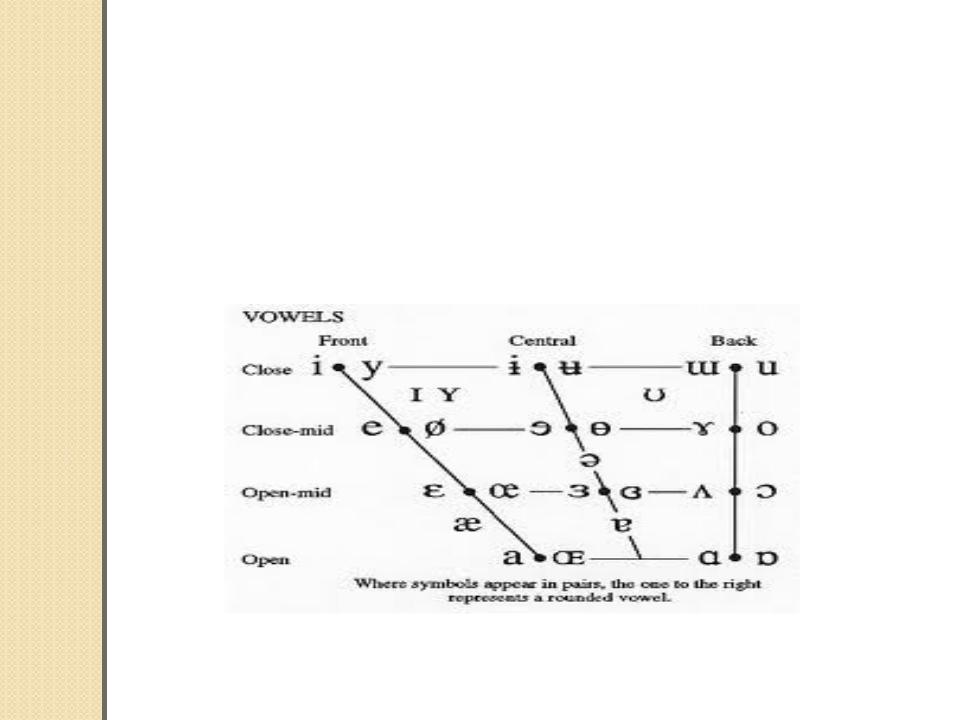
THE ENGLISH VOWELS
Vowels are sounds which are produced with the vibration of air in the oral cavity
All vowel sounds are voiced oral sounds
The relationship of the vowels to one another is shown by the device known as the Vietor Triangle
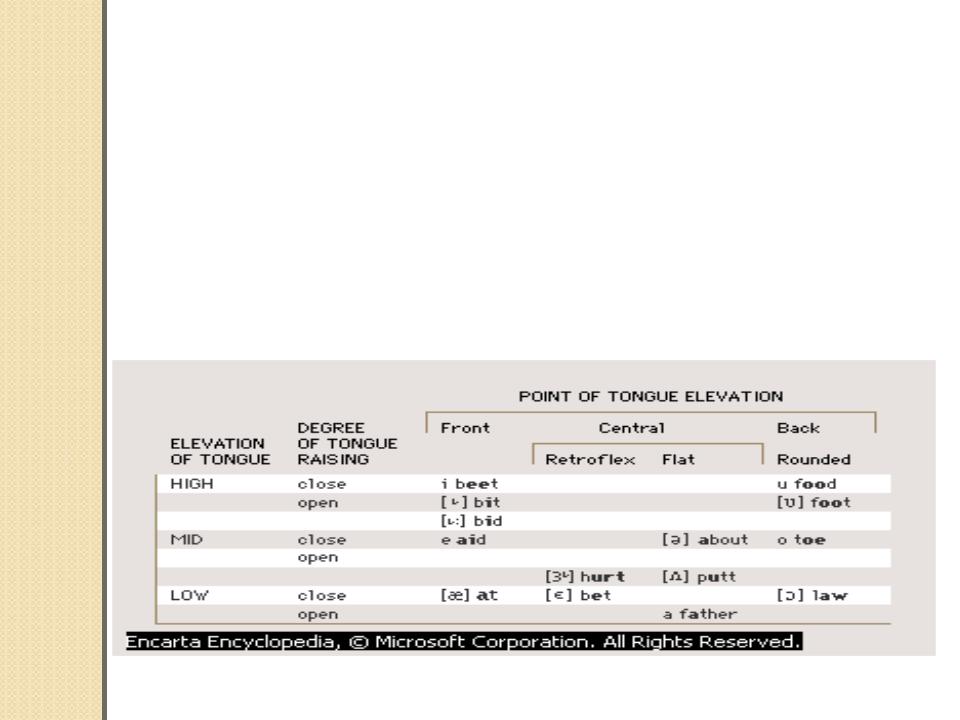
VIETOR TRIANGLE
– is a vowel triangle which shows the differences among the vowel sounds in English and their relative positions on the tongue
- |
|
Contains two axes: |
back of the mouth |
a. horizontal axis – from front to |
|
(front, center, back) |
roof of the mouth |
b. vertical axis – from the floor to the |
|
(high, mid, low) |
|
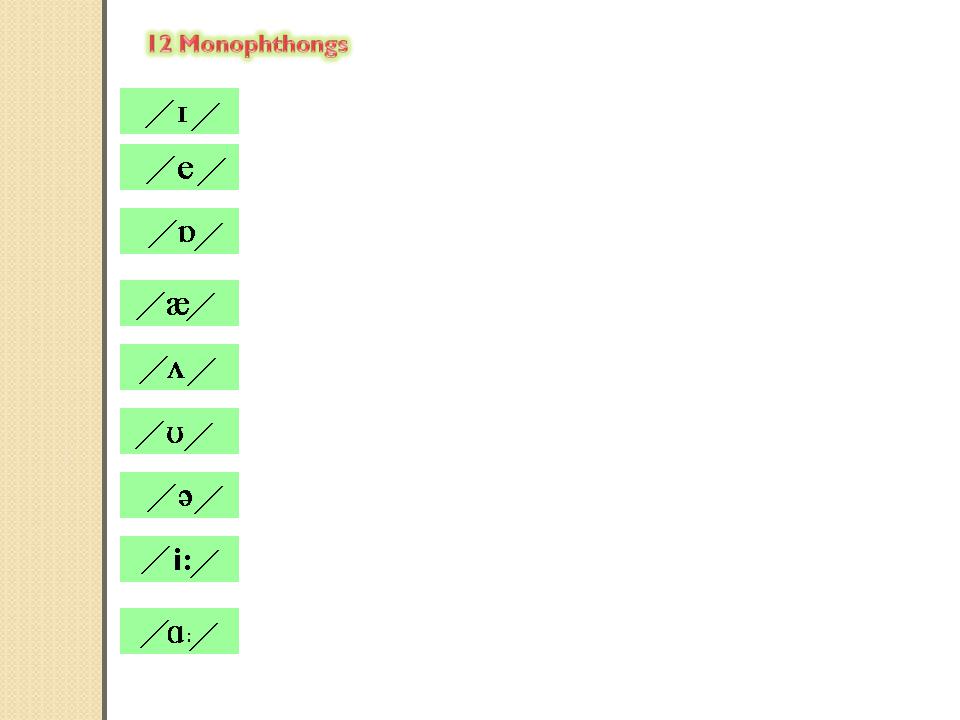
Lips loosely spread. Tongue lax with less tension than / i: / Example : Bid
Lips loosely spread and slighly wider apart than / ɪ / Example : Head
Open lip-rounding, wide open jaws, back of tongue low.Example : Hot
Lips neutrally open and slightly wider apart than / e / Example : Lamb
Lips neutrally open. Open jaws. Centralized quality. Example :
Love
Lips loose, but closely rounded. Tongue not as tense as in / u: /. Example : Good
Lips in neutral position. Centralized. Tongue slightly higher than in /ʌ/. Example : about
Lips spread. Tongue tense (front raised) with sides touching upper molars. Example : Seat
Lips neutrally open and jaws far apart. Centre to back of tongue fully open.Example : Heart

Medium lip rounding. Tongue drawn back making no contact with upper molars. Example : Four
Lips neutrally spread. Tongue slightly higher than /ə/ (no firm contact with upper molars). Example : girl
Lips closely rounded. Back of tongue high. Tense compared with /ʊ/. Example : Shoe
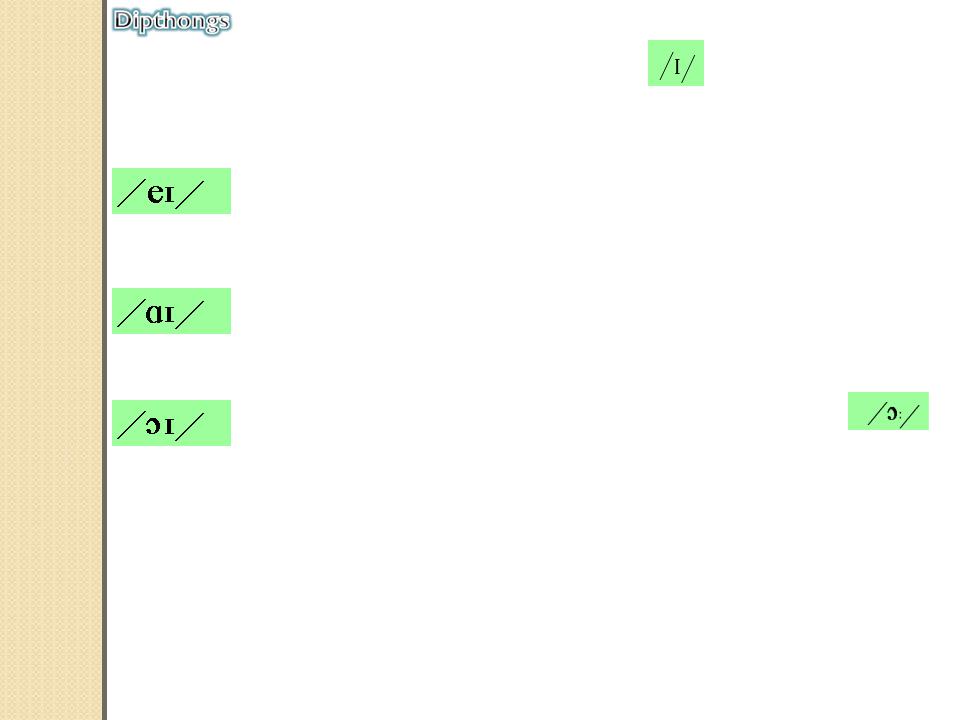
THE FIRST THREE DIPHTHONGS have the vowel
in "pit" or "if" as the FINISHING POSITION. To make this sound, your tongue has to be high and towards the front of your mouth and your lips kept relaxed.
as in day, pay, say, lay. The starting position is /e/ with tongue in mid position at front of mouth as in "egg", "bed" or "Ted". Therefore you move the tongue up to make the diphthong.
as in sky, buy, cry, tie. The starting position is /a/ , the same sound as in "car" or the noise "ah" which you make when you open your mouth at the dentist's. To make the diphthong you need a big jaw movement, less opening as you move the tongue up and front.
starting pas in boy, toy, coy or the first syllable of soya. osition is
the sound in "door" or "or". Your tongue needs to be low, but you need to pull it back and make your mouth round. To make the diphthong, you relax the lip rounding and move your tongue forward and up.
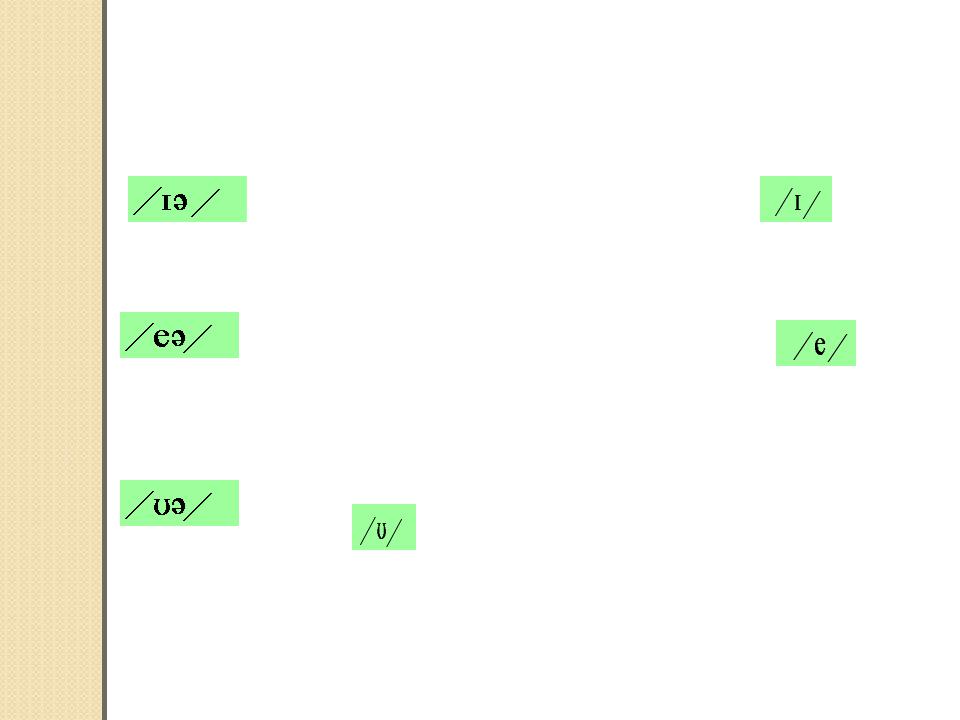
THE NEXT THREE DIPHTHONGS have the neutral "shwa" vowel
which occurs in grunting noises and the weak forms of "the" and "a", as the FINISHING POSITION. To make the neutral vowel sound keep your tongue fixed in the centre of your mouth, lips fairly relaxed and just grunt!
as in beer (the drink), pier, hear. The starting position is
as in "if" or "pit" with tongue front and high and lips relaxed.
as in bear (the animal), pair and hair. The starting |
is |
as in "egg" or "bed" with tongue in mid position at front of mouth. To make the diphthong, using a small controlled movement, pull your tongue slighty back from mid front to the mid central position in your mouth.
as in "tour", "poor" (talking posh!) or the first syllable of "tourist". startwingth tonguepositionpulledis back but small mouth
aperture as
in "hook", "book" or "look".To make the diphthong, this time the small controlled tongue movement goes from the back postion to the mid central position, losing the lip rounding and relaxing your mouth from the tight starting position.
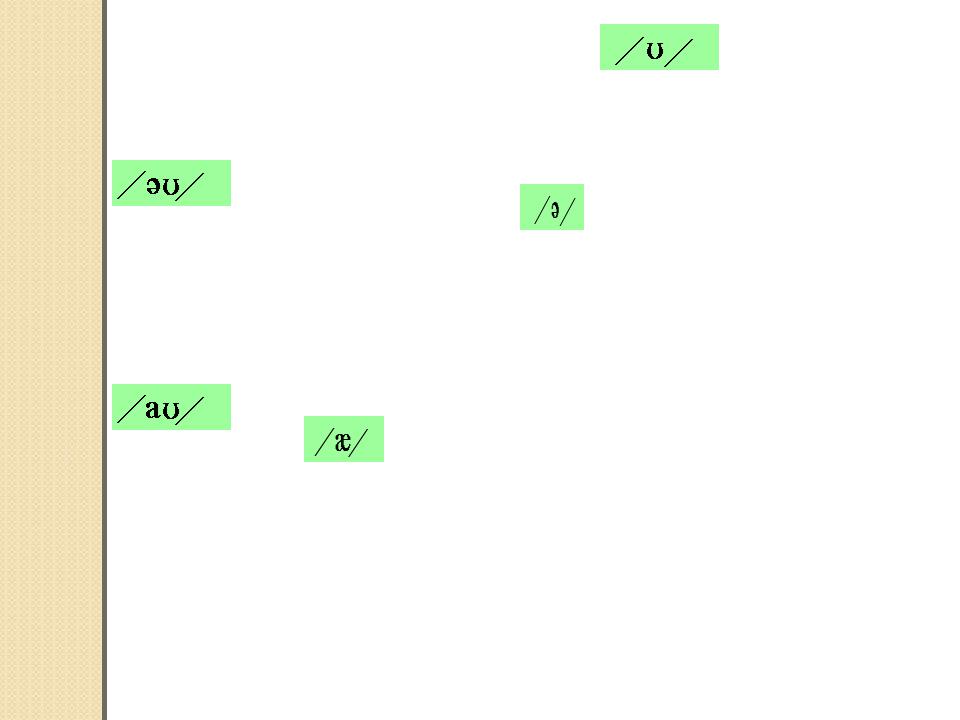
THE LAST TWO DIPHTHONGS have the back
(tongue pulled back but small tight mouth aperture as in "hook", "book" or "look") as the FINISHING POSITION.
as in "oh", "no", "so" or "phone". The starting position is the
neutral vowel sound, also |
as "shwa“ |
|
which sounds like a grunt, as in th |
weak form of "the" or "a". To start in this way, the tongue should be fixed in mid central position in your mouth with lips relaxed. To make the diphthong, it is a short controlled movement in the opposite direction of 5) above: from the centre to the back moving your relaxed lips into a tighter small round aperture. Your cheeks should move in a bit!
as in all the words of "How now brown cow!". The starting position theasvowelin "at"sound"bad" or "rat" with tongue front but also
low
(i.e. mouth open). To make the diphthong the journey for your tongue from front low (mouth very open) to back high (small tight mouth aperture) is a very long excursion. Your jaw will move a lot too.
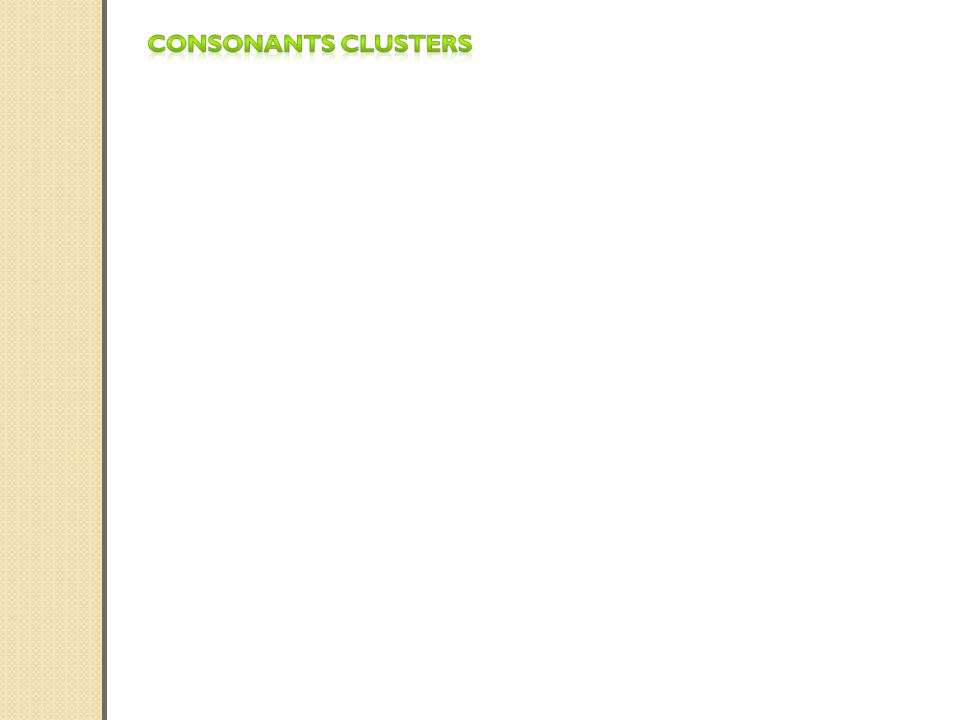
A consonant cluster is a group or sequence of consonants that appear together in a syllable without a vowel between them, such as the /sp/ combination in speak, spot, or the /skr/ combination in scrape, scream.
Consonant Cluster : 1) s+ (initial) p,t,k,f,m,n,w,l,y,r / s:pre-initial/others :initial
2) s+other consonant s+ (post-initials) l,r,w,j =pre-initial+initial+post- initials
The consonant clusters which constutute the coda are also not arbitrarily formed, they can be described as:
”any consonant except for h,r,w,j may be final consonant. There may be 2 kinds of Final Cluster : pre-final+final/final+post final, Pre- finals(m,n,nasal,l,s : bump,belt) / Post-finals (s, z, t, d, /q/ : bets,beds)”

The following worksheets and activities help with initial and final clusters.
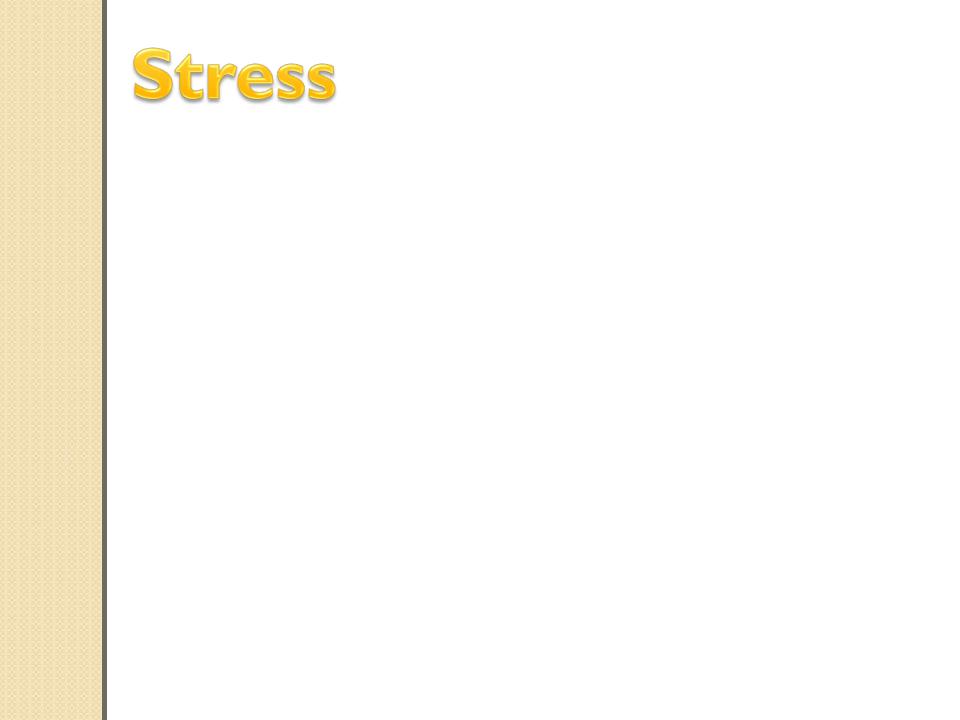
Stress is defined as using more more muscular energy while articulating the words. When a word or a syllable in word is produced louder, more lenghty, with higher pitch or with more quality, it will be perceived as stressed. The prominence makes some syllables be perceived as stressed. Words including long vowels and diphthongs or ending with more than 1 consonant are stronger, heavier and stressed.
Rules of Word Stress in English
There are two very simple rules about word stress:
One word has only one stress. (One word cannot have two stresses. If you hear two stresses, you hear two words. Two stresses cannot be one word. It is true that there can be a "secondary" stress in some words. But a secondary stress is much smaller than the main [primary] stress, and is Weonlycanusedonlyinstresslong wordsvowels,.) not consonants.
Here are some more, rather complicated, rules that can help you understand where to put the stress. But do not rely on them too much, because there are many exceptions. It is better to try to "feel" the music of the language and to add the stress naturally.
